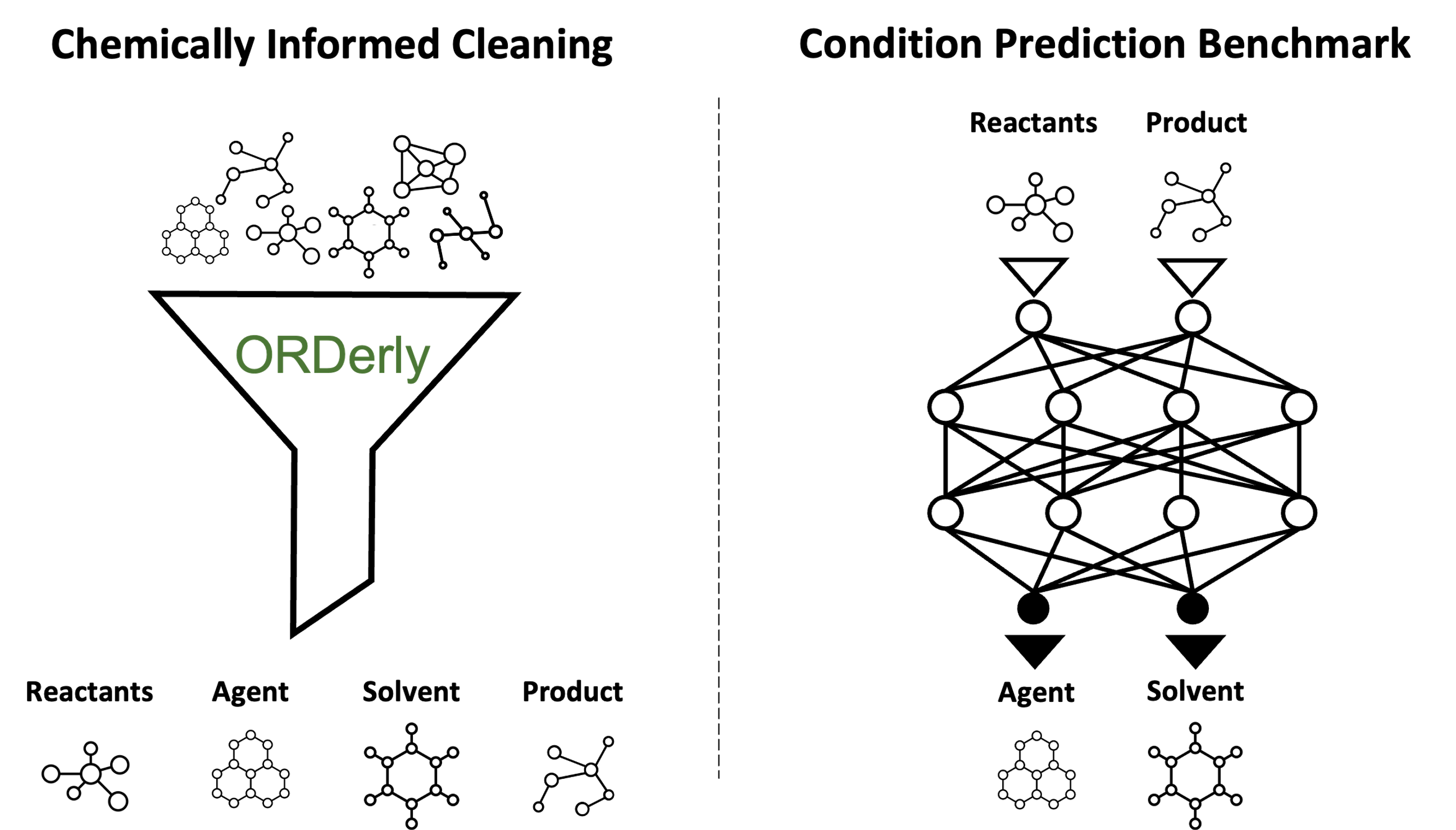This is the code for ORDerly: Datasets and benchmarks for chemical reaction data, which has been published in JCIM.
🧪 Cleaning chemical reaction data 🧪
🎯 Chemical Reaction Benchmarks 🎯
Requires Python 3.10 (Tested on MacOS and Linux)
pip install orderly
Machine learning has the potential to provide tremendous value to chemistry. However, large amounts of clean high-quality data are needed to train models
ORDerly cleans chemical reaction data from the growing Open Reaction Database (ORD).
Use ORDerly to:
- Extract and clean your own datasets.
- Access the ORDerly benchmark datasets for predicting reaction products, conditions, retrosynthesis, and yield.
- Reproduce results from our paper including training a ML model to predict reaction conditions.
Data in ORD format should be placed in a folder called /data/ord/. You can either use your own data, or the open-source ORD data.
To download the ORD data follow the instructions in the ORD repository (i.e. download Git LFS and clone their repository. E.g. brew install git-lfs -> git lfs install -> git lfs pull). Then place the data within a folder called /data/ord/.
python -m orderly.extract
If you want to run ORDerly on your own data, and want to specify the input and output path:
python -m orderly.extract --input_path="/data/ord/" --output_path="/data/orderly/"
This will generate a parquet file for each ORD file.
This will produce train and test parquet files, along with a .json file showing the arguments used and a .log file showing the operations run.
python -m orderly.clean
Reaction condition prediction is the problem of predicting the things "above the arrow" in chemical reactions.
There are three options for donwloading the benchmark.
- If you have orderly installed you can download the benchmark using this command:
python -m orderly.download.benchmark
-
Or you can either download the ORDerly condition prediction benchmark dataset directly
-
Or use the following code to download it (without installing ORDerly). Make sure to install needed dependencies first (shown below).
Toggle to see code to download benchmark
pip install requests fastparquet pandas
import pathlib
import zipfile
import pandas as pd
import requests
def download_benchmark(
benchmark_zip_file="orderly_benchmark.zip",
benchmark_directory="orderly_benchmark/",
version=2,
):
figshare_url = (
f"https://figshare.com/ndownloader/articles/23298467/versions/{version}"
)
print(f"Downloading benchmark from {figshare_url} to {benchmark_zip_file}")
r = requests.get(figshare_url, allow_redirects=True)
with open(benchmark_zip_file, "wb") as f:
f.write(r.content)
print("Unzipping benchmark")
benchmark_directory = pathlib.Path(benchmark_directory)
benchmark_directory.mkdir(parents=True, exist_ok=True)
with zipfile.ZipFile(benchmark_zip_file, "r") as zip_ref:
zip_ref.extractall(benchmark_directory)
download_benchmark()
train_df = pd.read_parquet("orderly_benchmark/orderly_benchmark_train.parquet")
test_df = pd.read_parquet("orderly_benchmark/orderly_benchmark_test.parquet")To reproduce the results from the paper, please clone the repository, and use poetry to install the requirements (see above). Towards the bottom of the makefile, you will find a comprehensive 8 step list of steps to generate all the datasets and reproduce all results presented in the paper.
We run the condition prediction model on four different datasets, and find that trusting the labelling of the ORD data leads to overly confident test accuracy. We conclude that applying chemical logic to the reaction string is necessary to get a high-quality dataset, and that the best strategy for dealing with rare molecules is to delete reactions where they appear.
Top-3 exact match combination accuracy (%): frequency informed guess // model prediction // AIB%:
| Dataset | A (labeling; rare->"other") | B (labeling; rare->delete rxn) | C (reaction string; rare->"other") | D (reaction string; rare->delete rxn) |
|---|---|---|---|---|
| Solvents | 47 // 58 // 21% | 50 // 61 // 22% | 23 // 42 // 26% | 24 // 45 // 28% |
| Agents | 54 // 70 // 35% | 58 // 72 // 32% | 19 // 39 // 25% | 21 // 42 // 27% |
| Solvents & Agents | 31 // 44 // 19% | 33 // 47 // 21% | 4 // 21 // 18% | 5 // 24 // 21% |
Where AIB% is the Average Improvement of the model over the Baseline (i.e. a frequency informed guess), where
There are two different ways to extract data from ORD files, trusting the labelling, or using the reaction string (as specified in the trust_labelling boolean). Below you see all the arguments that can be passed to the extraction script, change as appropriate:
python -m orderly.extract --name_contains_substring="uspto" --trust_labelling=False --output_path="data/orderly/uspto_no_trust" --consider_molecule_names=False
There are also a number of customisable steps for the cleaning:
python -m orderly.clean --output_path="data/orderly/datasets_$(dataset_version)/orderly_no_trust_no_map.parquet" --ord_extraction_path="data/orderly/uspto_no_trust/extracted_ords" --molecules_to_remove_path="data/orderly/uspto_no_trust/all_molecule_names.csv" --min_frequency_of_occurrence=100 --map_rare_molecules_to_other=False --num_product=1 --num_reactant=2 --num_solv=2 --num_agent=3 --num_cat=0 --num_reag=0 --consistent_yield=False --scramble=True --train_size=0.9
A list of solvents (names and SMILES) commonly used in pharmaceutical chemistry can be found at orderly/data/solvents.csv
Start by extracting all USPTO data:
python -m orderly.extract --name_contains_substring="uspto" --trust_labelling=False --output_path="data/orderly/uspto" --consider_molecule_names=False
If you would like to extract all data in ORD (instead of just USPTO data) simply set name_contains_substring="". Now select your desired dataset:
python -m orderly.clean --output_path="../orderly_generated_datasets/orderly_condition.parquet" --ord_extraction_path="data/orderly/extracted_ords" --molecules_to_remove_path="data/orderly/all_molecule_names.csv" --min_frequency_of_occurrence=100 --map_rare_molecules_to_other=False --set_unresolved_names_to_none_if_mapped_rxn_str_exists_else_del_rxn=True --remove_rxn_with_unresolved_names=False --set_unresolved_names_to_none=False --num_product=1 --num_reactant=2 --num_solv=2 --num_agent=3 --num_cat=0 --num_reag=0 --consistent_yield=False --scramble=False --train_size=0.9 --remove_reactions_with_no_reactants=True --remove_reactions_with_no_products=True --remove_reactions_with_no_solvents=False --remove_reactions_with_no_agents=False
python -m orderly.clean --output_path="../orderly_benchmarks/orderly_forward.parquet" --ord_extraction_path="data/orderly/uspto/extracted_ords" --molecules_to_remove_path="data/orderly/uspto/all_molecule_names.csv" --min_frequency_of_occurrence=0 --map_rare_molecules_to_other=False --num_product=2 --num_reactant=3 --num_solv=3 --num_agent=3 --num_cat=0 --num_reag=0 --consistent_yield=False --scramble=True --train_size=0.9 --remove_reactions_with_no_reactants=True --remove_reactions_with_no_products=True --remove_reactions_with_no_solvents=False --remove_reactions_with_no_agents=False
python -m orderly.clean --output_path="../orderly_benchmarks/orderly_retro.parquet" --ord_extraction_path="data/orderly/uspto/extracted_ords" --molecules_to_remove_path="data/orderly/uspto/all_molecule_names.csv" --min_frequency_of_occurrence=0 --map_rare_molecules_to_other=False --num_product=1 --num_reactant=2 --num_solv=-1 --num_agent=-1 --num_cat=0 --num_reag=0 --consistent_yield=False --scramble=True --train_size=0.9 --remove_reactions_with_no_reactants=True --remove_reactions_with_no_products=True --remove_reactions_with_no_solvents=False --remove_reactions_with_no_agents=False
python -m orderly.clean --output_path="../orderly_benchmarks/orderly_yield.parquet" --ord_extraction_path="data/orderly/uspto/extracted_ords" --molecules_to_remove_path="data/orderly/uspto/all_molecule_names.csv" --min_frequency_of_occurrence=0 --map_rare_molecules_to_other=False --num_product=1 --num_reactant=2 --num_solv=-1 --num_agent=-1 --num_cat=0 --num_reag=0 --consistent_yield=True --scramble=True --train_size=0.9 --remove_reactions_with_no_reactants=True --remove_reactions_with_no_products=True --remove_reactions_with_no_solvents=False --remove_reactions_with_no_agents=False
First extract all non-USPTO data with the extraction script.
python -m orderly.extract --name_contains_substring="uspto" --trust_labelling=False --output_path="data/orderly/not_uspto" --consider_molecule_names=False --inverse_substring=True
Next, simply use the same cleaning script as for USPTO (e.g. ORDerly-retro) for your desired task. The data will then be cleaned in the same way. This is a nice way to create test sets with no leakage.
Submit an issue or send an email to dsw46@cam.ac.uk.
If you find this project useful, we encourage you to
- Star this repository ⭐
- Cite our paper.
@article{Wigh2023,
author = "Daniel Wigh, Joe Arrowsmith, Alexander Pomberger, Kobi Felton, and Alexei Lapkin",
title = "{ORDerly: Datasets and benchmarks for chemical reaction data}",
year = "2023",
month = "8",
url = "https://chemrxiv.org/engage/chemrxiv/article-details/64ca5d3e4a3f7d0c0d78ca42",
journal = "ChemRxiv"
}

